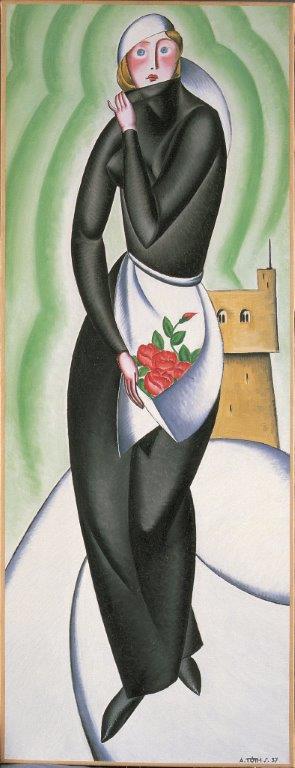Everyone who is a bit familiar with Western art history sees that this painting is derived from Ophelia (1852) by the Pre-Raphaelite painter Millais. That painting became one of the best-known illustrations of William Shakespeare’s play Hamlet from 1602. This tragedy discusses the weight of mortality and the complexity of issues of life and death. Eight of the nine leading figures die by the end. There is an obvious evil force at work in the deteriorating environment. Ophelia, after Hamlet kills her father, goes mad and dies under suspicious circumstances. In Millais’ artwork her innocence is illustrated not only by the flowers but also by her pose: she lies with open arms resembling a saint or a martyr.
Photography was invented just a few years before that work was painted, yet sharp images with vibrant colors were only possible in the realm of painting. The detailed rendition of the flora on the riverbank is of such a quality that botany classes used to learn from it on bad weather days – as the story goes.
Not much botany to learn in our times. Our Ophelia is lying in water polluted by plastic bottles. The trash looks menacingly beautiful. Even though photography is an inalienable part of our lives by now, this realism can surprise us. We are led by the brush of the painter to see things the way he wants us to see them. It is different from photography. Some things are sharpened, others are blurred. It is a study on how to paint nuances: the reflection and movement of the water, the broken daylight touching surfaces of different materials, things changing below the surface of the water.
The unified tonality of blue-green is contrasted by the only flower, a perfectly white lotus. It signifies purity, revival, rebirth. One might associate it with unwavering faith as it submerges in the evening and then emerges to flower every morning. In Eastern traditions it is often pictured alongside divine figures.
Ophelia is floating relaxedly amidst the garbage but her arms are stretched in the position of a crucifixion. And the invisible depth seems to pull her down.
*
Hansa Versteeg Ophelia, 2020, oil on canvas 74 x 110 cm
*
This art contemplation by Anikó is published in the book ‘Compassionism’. The book, as well as high quality reproductions and some originals are available via the website of the artist: www.hansaversteeg.com.

